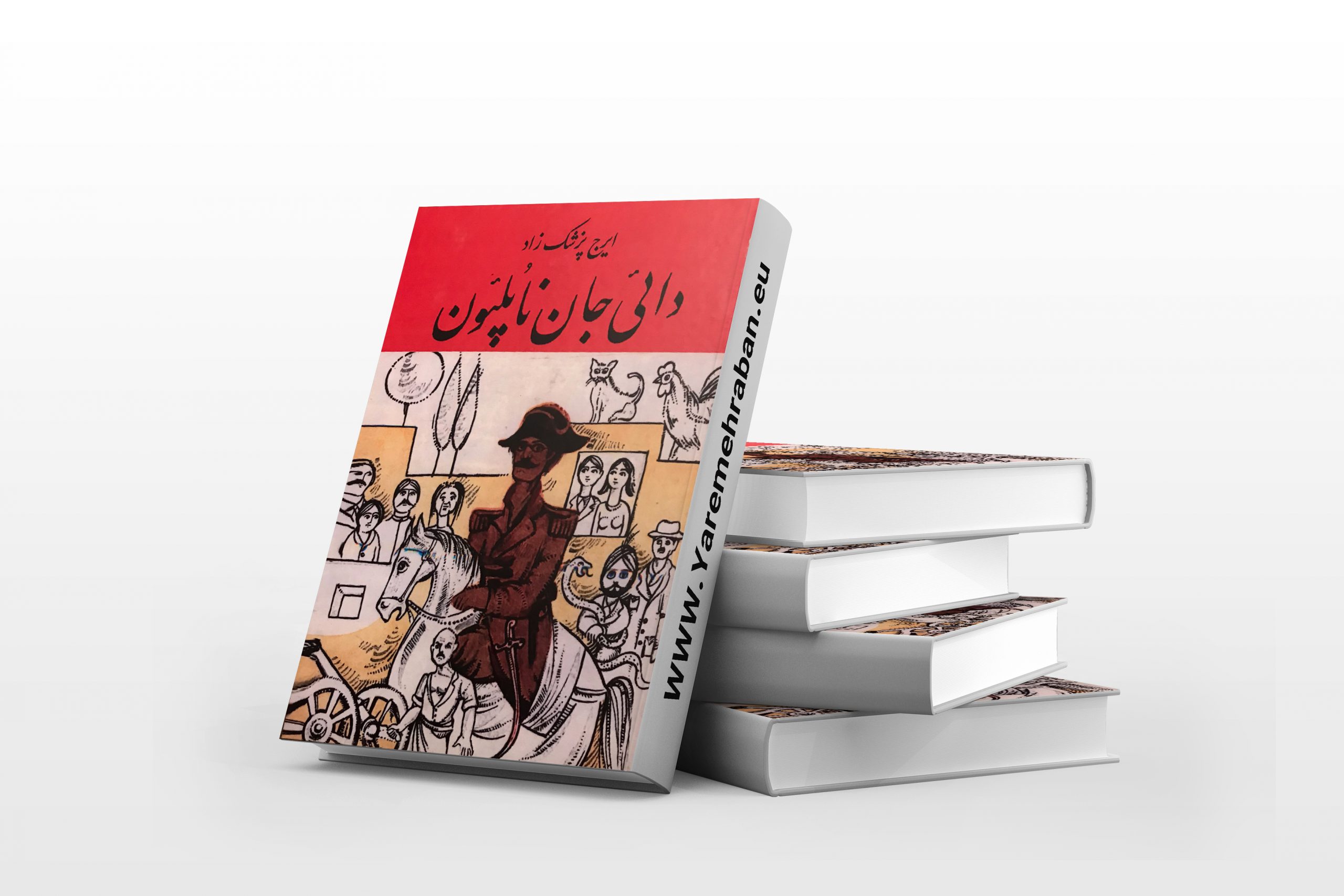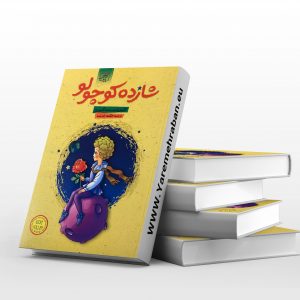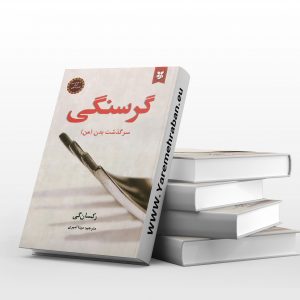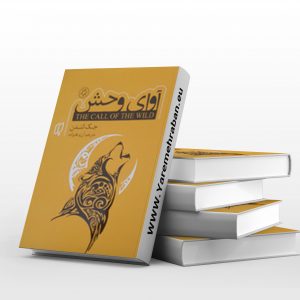Description
Introducing the book
My Uncle Napoleon by Iraj Pezeshkzad
My Uncle Napoleon’s is a satirical novel published in 1349. The book has been translated into eight languages and the book genre is a combination of social, maturity and
The book of Napoleon’s uncle
Satire has a long history in Iranian literature. From the time “Obaid Zakani” composed the poem “Mouse and Cat” until today, lasting satirical works have been written in Persian literature.
Many of these satirical works have used the weapon of the pen to express the weaknesses of society, and this method of social critique has spread from classical literature to contemporary literature. Uncle John Napoleon by Iraj Pezeshkzad is the most unique contemporary Persian story that has criticized the folk humor and folk customs of the society of the forties of Iran with the language of humor.

a book for all generations
My Uncle Napoleon
John Napoleon’s Uncle’s novel is the result of combining the author’s failed love story with his family adventures. The story is about a boy in love with a profession named Saeed who falls in love with his cousin Lily. Saeed’s family lives with Uncle Jan’s family and several other families in a large garden and several mansions. Iraj Pezeshkzad, the author of the book, says that the garden in which the story is told is inspired by the garden in which Pezeshkzad spent his childhood. The garden he inherited from his mother and lived with his aunts and uncles.
This book was first published as a footnote in Ferdowsi Magazine in 1350. In those years, Pezeshkzad referred to the wards of John Napoleon’s aunt under the pseudonym “A. P. Ashna “was printing.
Uncle John Napoleon’s book became so popular that when it was published in 1973, it immediately reached its third edition. This novel narrates a love story with a humorous pen and criticizes the Iranian society with a pen. Pezeshkzad considers the main theme of the book to be “the confrontation of the old class and the national models of society with the educated youth.”
Where do the characters of Napoleon’s uncle come from?
The meticulous characterization and deep psychology of the characters make the reader think that Iraj Pezeshkzad lived with these characters, but the author says about this: “They did not.” “I have combined several characters to create these characters, and perhaps the only real aspect of this story is the narration of Saeed’s love for Lily,” he emphasizes.
Pezeshkzad confesses in an interview that he falls in love with a girl of his own age as a teenager. He chose the field of law to reach his beloved, because the period of this field was shorter than medicine – that is, his father’s field of specialization – and only in this way could Pezeshkzad reach his beloved earlier.
Iraj Pezeshkzad says that part of Daeijan’s character was inspired by his father: “Although my father was a doctor, he was also an understanding doctor. “But there was not a single incident in which he was out of touch with the British and did not hold the British responsible.”
Mashghasem, Pezeshkzad’s favorite character, was in fact one of the employees of Pezeshkzad’s acquaintances. The main name of this character was Mash Abbas, who answered all the questions of his physician and his peers in his childhood.
The source of Assadollah Mizra’s character was in fact a relative of Iraj Pezeshkzad, named Abolfazl Mirza, who had a witty and funny personality. The character of Uncle Assadollah Mirza in the book is someone who was educated in France and has a good relationship with women.
My Uncle Napoleon; The story of maturity
Uncle John Napoleon’s book is one of the best examples of fourteenth-century Persian fiction. Uncle John Napoleon’s book falls into the category of puberty stories. In this genre of books, the protagonist, usually a teenager or young man, undergoes changes throughout the story that cause his character to grow and mature. Puberty books are often combined with other genres. “The Face of an Artist in Youth” by James Joyce and “Harry Potter” by JK Rowling are some of the best Western examples of this genre. Uncle John Napoleon’s book is the most exemplary example of this genre in Persian literature.
Get to know Uncle John Napoleon’s creator
Iraj Pezeshkzad Iraj Pezeshkzad is one of the greatest comedians in the history of Iran. He has been writing for more than sixty years and has written more than twenty books. Iraj Pezeshkzad began his artistic life writing short stories for magazines and translating the writings of Voltaire and Moliere and several historical novels.
He had a satirical column in “Ferdowsi” magazine called “Asmoon and Rismon” in which he published his satirical articles every week. Iraj Pezeshkzad’s works are divided into three general categories: humor, history and translation. “Mashallah Khan in the court of Harun al-Rasheed”, “The city of Farang of all colors” and “Man is polite to his government” are examples of his comic books.
Iraj Pezeshkzad, like his protagonist, Saeed, was born into large and aristocratic families. He completed his education in France and worked in the judiciary for some time. He then served in the State Department because of his knowledge of the language. Uncle John Napoleon’s book is the product of his years as Deputy Consul General in Austria.
Pezeshkzad considers Saadi, the king of speech, to be the main source of his inspiration. He wrote a book called “Saadi’s glorious satire” in 2002, in which he studied the tone of Saadi’s satire in Bustan and Golestan.
Various translations of Uncle John Napoleon’s novel
Uncle John Napoleon’s novel has been translated into eight living languages of the world. The first translation of this book into Russian was published in 1981. After that translation, Dick Davis translated Uncle John Napoleon’s book into English. With great skill, Davis was able to preserve the humor of Pezeshkzad’s story in the English version as well. Commenting on Uncle John Napoleon’s book, Davis said: “This novel has many qualities that make it a masterpiece. The extraordinary medical humor that makes it one of the most important books of the twentieth century.” “I translated this book to change the West’s view of Iranians after the revolution,” he said.
Davis considers the translation of Mash Qasim’s dialogues to be the most difficult part of translating his book. He says he has rewritten all of Qasim’s dialogues at least three times. He first wrote them in the tone of a village where he grew up in England, but after reviewing it, he realized that the main point was not conveyed to the audience well. Davis translated the dialogues into plain English a second time, but again he was not satisfied. He last used a combination of these two tones to translate Mash Qasim’s dialogues, and finally published the book in the same tone.
Uncle John Napoleon series; The most enduring Iranian series
The prose of Uncle John Napoleon’s book was, in fact, the most enduring screenplay in the history of Iranian television. Nasser Taghvaei turned Pezeshkzad’s masterpiece into a television masterpiece by writing the screenplay for the series Uncle John Napoleon from the original text of the book and then directing this work in 1976.
The cast of this series was very professional and carefully selected. The careful selection of actors along with Iraj Pezeshkzad’s unique characterization made the characters created in this TV series more famous than the creator of the book. Gholam Hossein Naghshineh has played the role of Daei Jan, Parviz Fanizadeh has played the role of Mash Qasem and Parviz Sayad has played the role of Assadollah Mirza. The filming location of this series was the house and garden of the union, whose main owner was Amin Al-Sultan. This house was purchased in 2015 by Tehran Municipality.
In a part we read about Uncle John Napoleon
I tried to check all my information about love. Unfortunately, this information was not extensive. Although I was more than thirteen years old, I had never seen a lover before. Romance books and biographies of lovers were also very little published at that time. They just wouldn’t let us read them all. Parents and relatives, especially Uncle John, whose shadow of existence and thoughts were on the heads of all members of the family, forbade us children to leave the house unprotected, and we did not dare to approach the children on the street. The radio, which had not been open for a long time, did not have much material in its daily program for two or three hours to help clear our minds.
While reviewing my information about love, I first came across Lily and Majnoon, whose story I had heard many times. But as I explored the corners of my brain, I saw that I had not heard anything about how madly Lily fell in love. They just said that Majnoon fell in love with Lily.
Maybe it would have been better if I had not mentioned Lily and Majnoon in this review. Because the fact that Lily and Uncle John’s daughters were all together probably influenced my next conclusions without my knowing it. But I had no choice. The most important lovers I knew were Lily and Majnoon. Other than that, I did not know much about Shirin and Farhad, especially how they fell in love. I had also read a love story published in a newspaper footnote, but I had not read the first few issues and one of my classmates had told me. As a result, I did not
know the beginning of the story.
1- Introducing the book on YouTube
2- Introducing the book in Aparat














Reviews
There are no reviews yet.